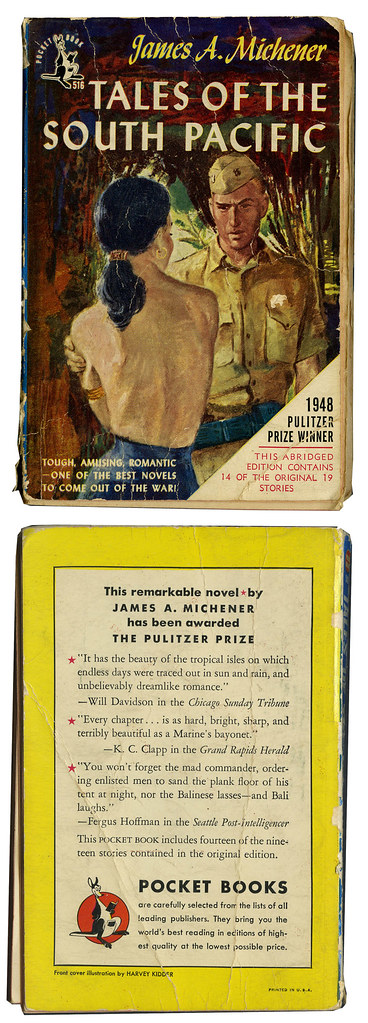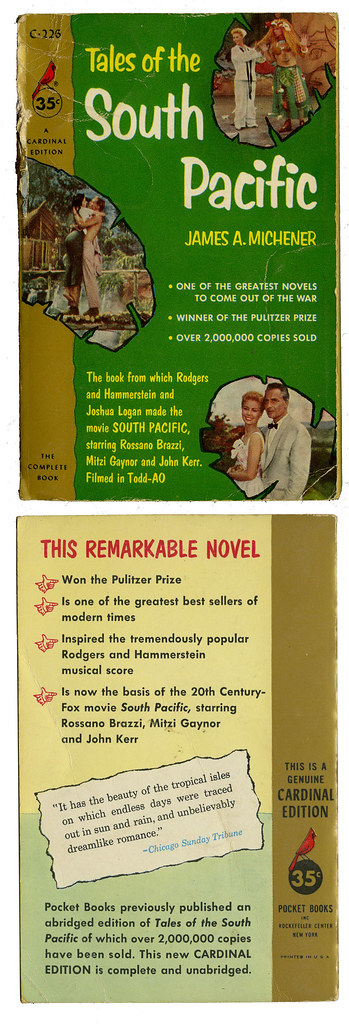Let's see, which song comes to mind first? Some Enchanted Evening, I'm Going to Wash That Man Right Out of My Hair, Happy Talk, or You've Got to be Taught?
Two vintage paperbacks of the same book, James A. Michener's Tales of the South Pacific.
This first one I've had for probably over 40 years and was in a stack of books friends gave us when they sold their cabin. I just moved all the books over to my folks cabin. It was printed in 1950, 16th edition.
This second one, the actual movie tie-in book, I found at the post office on a book exchange table. You bet your sweet bippy I grabbed it. This copy was published in 1958.
What's really fascinating is what's on the first page of the oldest book:
This novel--which won the Pulitzer Prize "for distinguished fiction in book form"--was written by a man of 40 whose only previous books were scholarly research studies. The manuscript (submitted anonymously) was accepted by its original publishers without knowing that the author was one of their own staff editors.What I don't understand is why haven't I ever read this? It's now on my stack of must read books.
From Wikipedia:
Tales of the South Pacific is a Pulitzer Prize winning collection of sequentially related short stories about World War II, written by James A. Michener in 1946 and published in 1947. The stories were based on observations and anecdotes he collected while stationed as a lieutenant commander in the US Navy on the island of Espiritu Santo in the New Hebrides Islands (now known as Vanuatu).The stories take place in and surrounding the Coral Sea and the Solomons. Michener gives a first-person voice to several as an unnamed "Commander" performing duties similar to those he performed himself. The stories are interconnected by recurring characters and several loose plot lines (in particular, preparations and execution of a fictitious amphibious invasion code-named "Alligator") but focus on interactions between Americans and a variety of colonial, immigrant and indigenous characters. The chronology of the stories takes place from the building of an airfield on Norfolk Island before the Battle of the Coral Sea in 1942 to the early 1944 invasion of the fictional island. Although primarily about the U.S. Navy, most of the action is shore-based, and none concerns ships larger than an LCI.The musical play South Pacific (which opened on Broadway on April 7, 1949), by Rodgers and Hammerstein, was based on these stories. Characters from the stories are merged and simplified to serve the format of the musical. For example, while the coastwatcher in the musical was portrayed as an American Marine (Lt. Cable) assisted by an expatriate French plantation owner (Emile de Becque), in the original story ("The Remittance Man"), the coastwatcher was an English expatriate assisted by his native companions. This coastwatcher is a disembodied voice on a short-wave radio, and is never seen by the characters in the story until his head is found impaled on a stake by a search-and-rescue party. The character of de Becque in the short story has eight mixed-race illegitimate daughters by four different women, none of whom he married, when he meets the nurse Ensign Nellie Forbush. In the musical, he has two legitimate mixed-race children by a woman whom he had married and who had died.
Go ahead, tell me which South Pacific songs pops into your head first.














Ha Ha, I was already singing the song as I was reading the post. You know which one it was.
ReplyDeleteI'm guessing it begins with "some" and ends with "evening."
ReplyDeleteNo way! It involves shampoo.
ReplyDelete